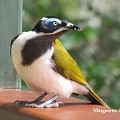
The welcome swallow (Hirundo neoxena) is a small passerine bird in the swallow family. It is a species native to Australia and nearby islands. Eastern populations are largely migratory, wintering in northern Australia. Both its species name and common name refer to people welcoming its return as a herald of spring in southern parts of Australia.
The welcome swallow is a small size bird and is fast-flying. Their flying style is circular in pattern with swift darting motions. They have graceful shape and flight, moreover they often fly singly, in couples or in clusters.[7] The welcome swallow is metallic blue-black above, light grey below on the breast and belly, and rusty on the forehead, throat and upper breast. It has a long forked tail, with a row of white spots on the individual feathers.




Once the welcome swallow reaches maturity it has a long breeding period. They have a monogamous social structure and a breeding period that lasts from August until March. The nest is an open cup of mud and grass, made by both sexes, and is attached to a structure, such as a vertical rock wall or building. It is lined with feathers and fur, and three to five eggs are laid. Two broods are often raised in a season. These birds are extremely agile fliers, which feed on insects while in flight. Welcome swallows do show a habit of drinking water while flying, they do this by scooping water within their bills from lake and pond surfaces. This is because welcome swallows need to drink water frequently, which allows them to catch insects in the water as well. https://en.wikipedia.org/wiki/Welcome_swallow


